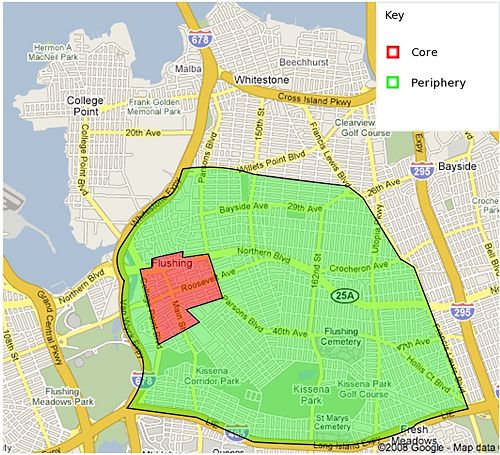Main Page
From The Peopling of New York City
Introduction
In 1657, citizens of Flushing developed and signed the Flushing Remonstrance [1] which upheld religious freedom for all citizens of Flushing. This was the first document to establish religious tolerance in the new world. Currently, Flushing is in the middle of a new struggle over tolerance however, in 2008, this battle concerns language and development. Along with Flushing’s vast diversity have come differences of many kinds. This website provides an account of Flushing's demographic, social, and physical landscapes, and current debates about language barriers, commerical signage and development, and traffic congestion. Will Flushing be able to adapt and remedy such differences as they did in the past?
Professor Hum’s Peopling of New York City’s class has developed a comprehensive website that explores these multiple dimensions of Flushing, and we have met with various stakeholders to learn how Flushing's diversity is both an asset and a challenge to building community. We have divided our research into three themes including the poly-ethnicity of Flushing, neighborhood diversity and race relations, and community institutions. We explored these aspects as thoroughly as possible to see if we could reach some answer to our question. We have partnered with a nonprofit organization, Center for Social Inclusion [2], and their former deputy director and consultant, Mafruza Khan, to examine Flushing as a “lens” to the rich and complex issues that shape daily life in one of NYC's most diverse immigrant neighborhoods. We hope you enjoy our site and learn about the unique town of Flushing, New York.
Links to our Pages
Conclusion
Flushing is a neighborhood that clearly exemplifies an evolving urban America. While most perceive this area as being a New York City satellite Chinatown, this is not the case. Flushing residents include long-time African Americans and Non-Hispanic Whites including a notable Jewish community, as well as immigrant Koreans, Chinese, South Asians, and Latinos including a growing Mexican and Central American population. The representation of these groups can be found in numerous ways throughout the neighborhood in visible ethnic landscapes such as commercial signage and religious institutions, and in less visible or "hidden" landscapes, for example, Flushing's Latino workforce including day laborers. Each contributes its own particular influence in shaping the diversity of Flushing.
Through our investigation on how diversity poses both a challenge and an asset to community relations, we have learned that tensions can arise over issues such as overdevelopment, feelings of exclusion from ethnic businesses, and simple miscommunication. Despite these tensions, Flushing is a neighborhood where diverse cultures are able to co-exist and flourish in a community that promotes both intra-racial and inter-racial ties. While the historic Flushing Remonstrance served as a precedent for the United States Constitution's Bill of Rights provision on religious tolerance, our study illustrates how Flushing is still a model for the nation as Flushing's diversity and capacity to adapt and evolve abounds. As a recent New York Times article claims, Flushing is "America's Melting Pot on a High Boil".

